Analysis of Tango's Pre-Digital Campaign for Integrated Marketing
VerifiedAdded on 2023/01/11
|14
|4393
|66
Report
AI Summary
This report provides a comprehensive analysis of an integrated marketing communications campaign, using the example of Tango, a canned soda. It begins with an introduction to integrated marketing and its importance in the current business environment, followed by an examination of the target audience, which is identified as the youth demographic. The report then outlines the communication objectives, emphasizing the importance of understanding customer needs and manipulating them in favor of the brand. A detailed discussion of multi-channel campaigns follows, covering inbound and outbound marketing, search engine optimization, customer relationship management, new media, and digital marketing, as well as the concept of Return on Investment (ROI). The report also delves into the methods for evaluating a marketing campaign's effectiveness, including monitoring sales, gathering customer feedback, analyzing key performance indicators, assessing competitive advantage, and calculating ROI. The overall goal is to develop a marketing campaign for the contemporary audience.
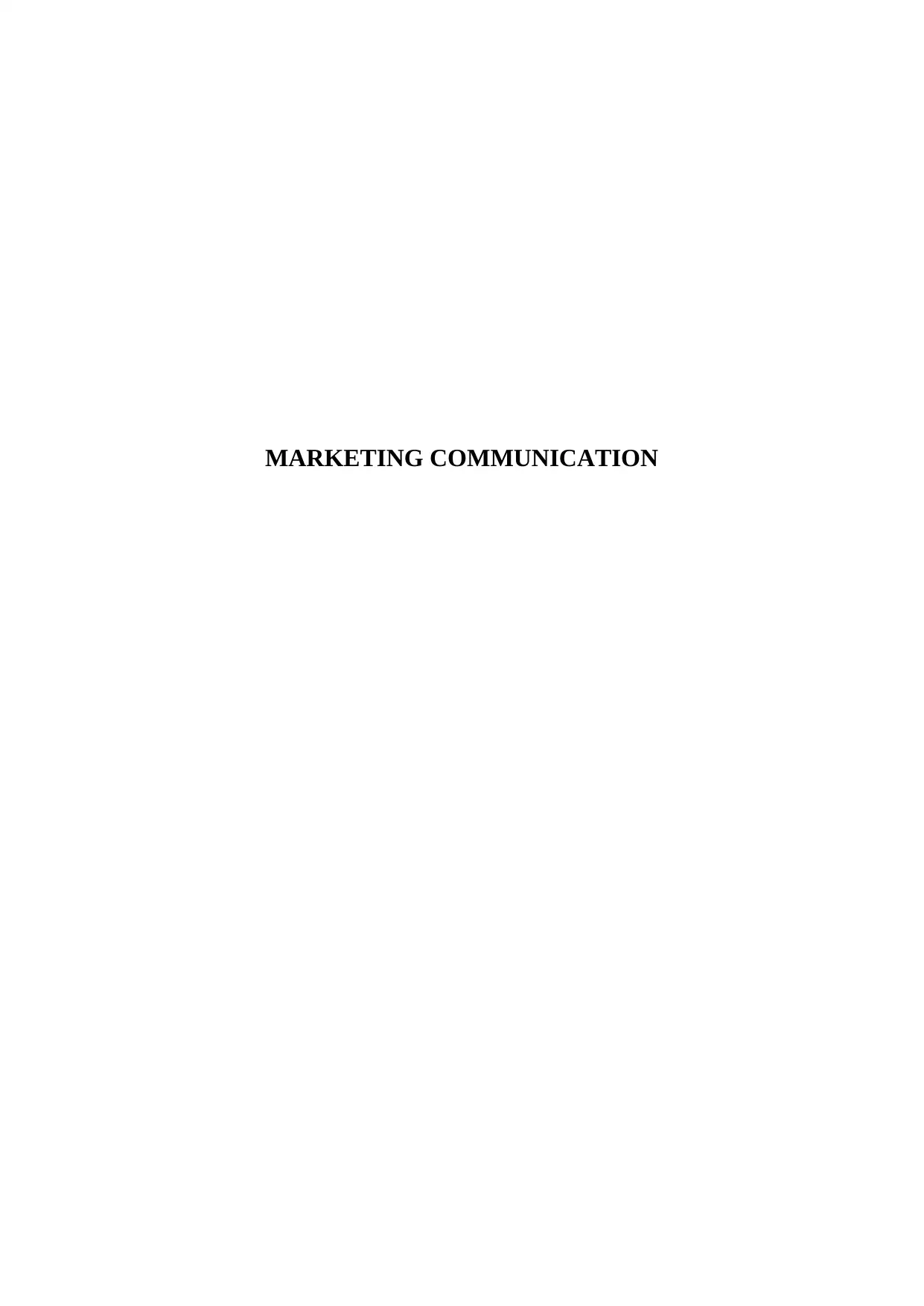
MARKETING COMMUNICATION
Paraphrase This Document
Need a fresh take? Get an instant paraphrase of this document with our AI Paraphraser
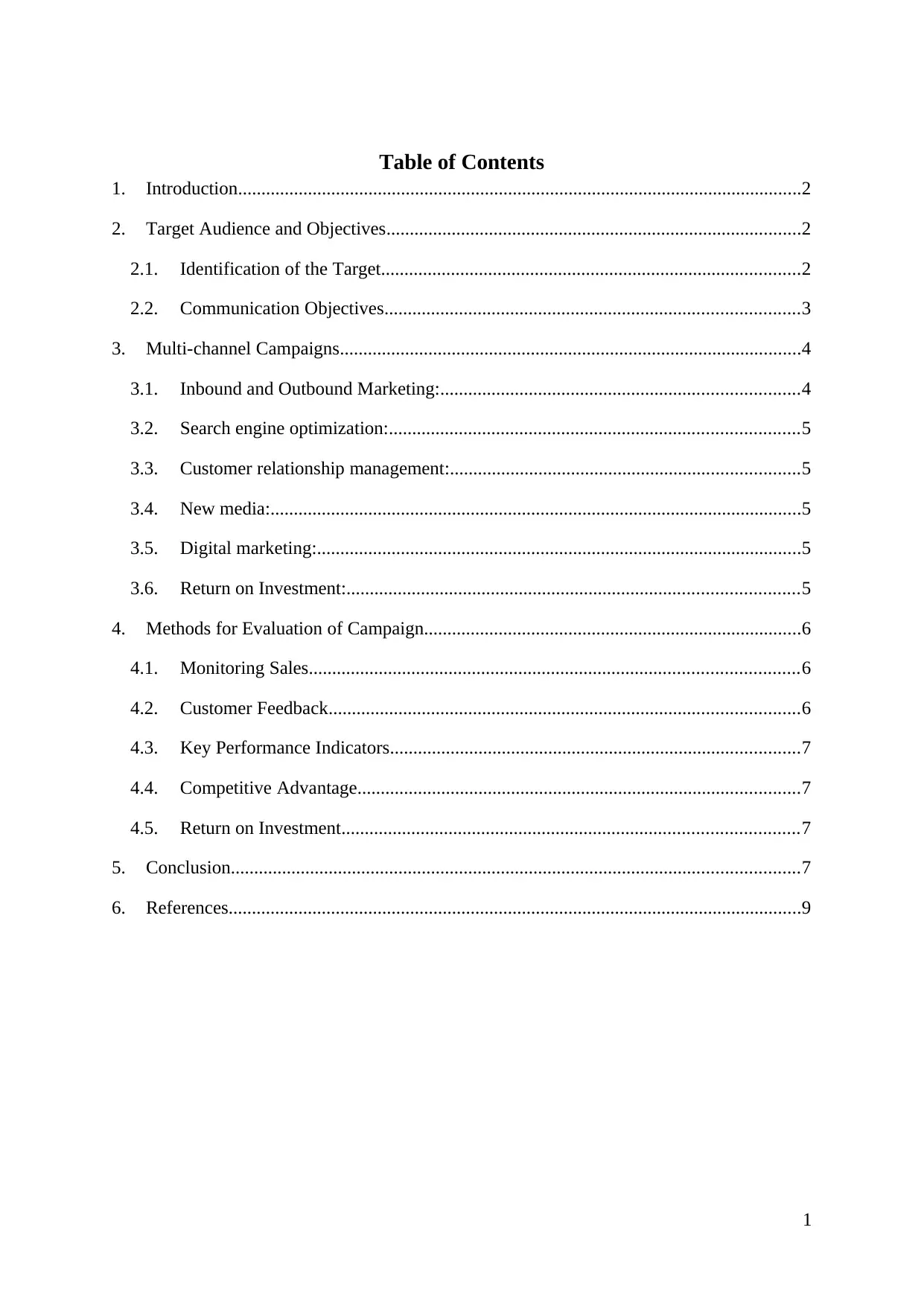
Table of Contents
1. Introduction.........................................................................................................................2
2. Target Audience and Objectives.........................................................................................2
2.1. Identification of the Target..........................................................................................2
2.2. Communication Objectives.........................................................................................3
3. Multi-channel Campaigns...................................................................................................4
3.1. Inbound and Outbound Marketing:.............................................................................4
3.2. Search engine optimization:........................................................................................5
3.3. Customer relationship management:...........................................................................5
3.4. New media:..................................................................................................................5
3.5. Digital marketing:........................................................................................................5
3.6. Return on Investment:.................................................................................................5
4. Methods for Evaluation of Campaign.................................................................................6
4.1. Monitoring Sales.........................................................................................................6
4.2. Customer Feedback.....................................................................................................6
4.3. Key Performance Indicators........................................................................................7
4.4. Competitive Advantage...............................................................................................7
4.5. Return on Investment..................................................................................................7
5. Conclusion..........................................................................................................................7
6. References...........................................................................................................................9
1
1. Introduction.........................................................................................................................2
2. Target Audience and Objectives.........................................................................................2
2.1. Identification of the Target..........................................................................................2
2.2. Communication Objectives.........................................................................................3
3. Multi-channel Campaigns...................................................................................................4
3.1. Inbound and Outbound Marketing:.............................................................................4
3.2. Search engine optimization:........................................................................................5
3.3. Customer relationship management:...........................................................................5
3.4. New media:..................................................................................................................5
3.5. Digital marketing:........................................................................................................5
3.6. Return on Investment:.................................................................................................5
4. Methods for Evaluation of Campaign.................................................................................6
4.1. Monitoring Sales.........................................................................................................6
4.2. Customer Feedback.....................................................................................................6
4.3. Key Performance Indicators........................................................................................7
4.4. Competitive Advantage...............................................................................................7
4.5. Return on Investment..................................................................................................7
5. Conclusion..........................................................................................................................7
6. References...........................................................................................................................9
1
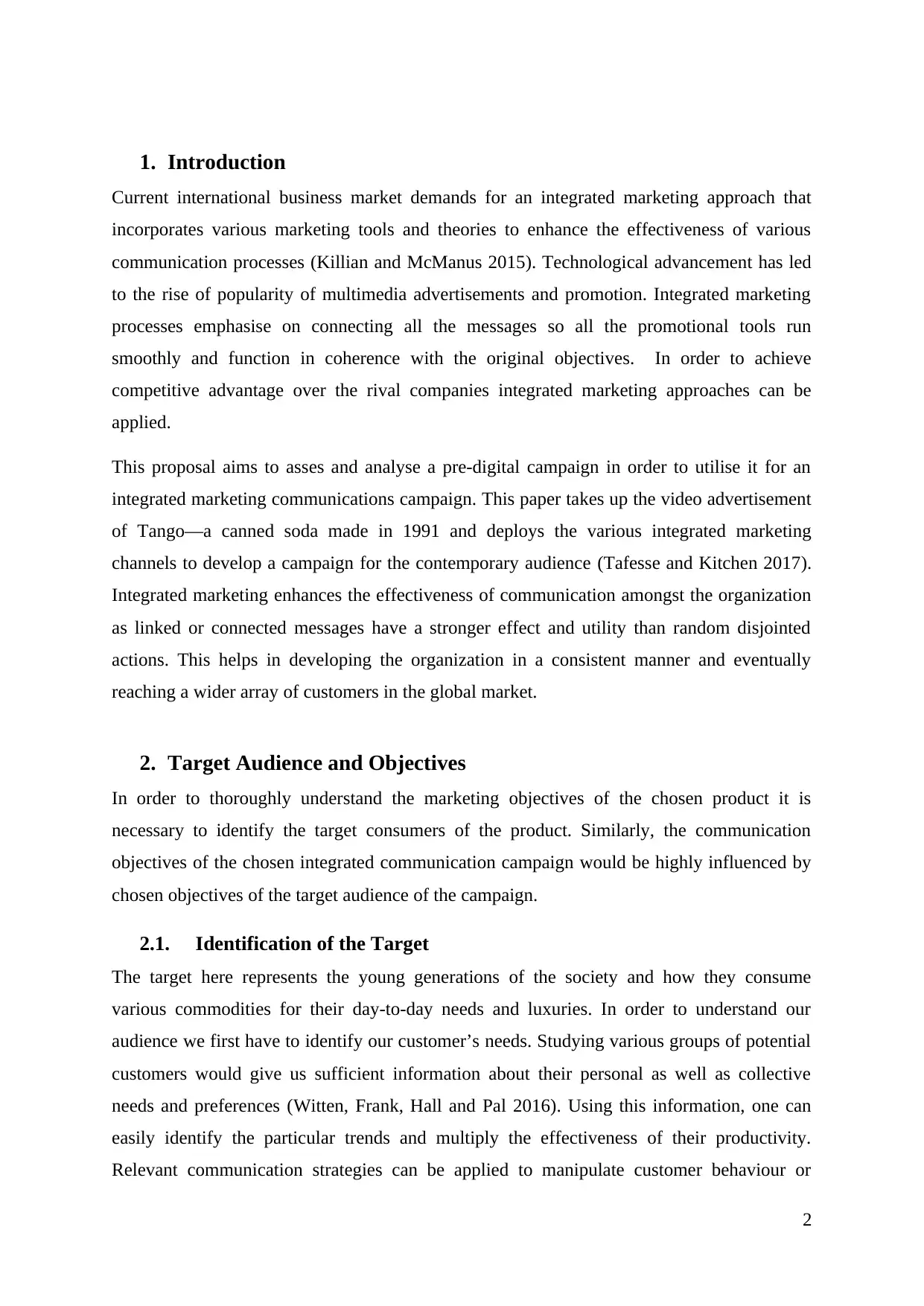
1. Introduction
Current international business market demands for an integrated marketing approach that
incorporates various marketing tools and theories to enhance the effectiveness of various
communication processes (Killian and McManus 2015). Technological advancement has led
to the rise of popularity of multimedia advertisements and promotion. Integrated marketing
processes emphasise on connecting all the messages so all the promotional tools run
smoothly and function in coherence with the original objectives. In order to achieve
competitive advantage over the rival companies integrated marketing approaches can be
applied.
This proposal aims to asses and analyse a pre-digital campaign in order to utilise it for an
integrated marketing communications campaign. This paper takes up the video advertisement
of Tango—a canned soda made in 1991 and deploys the various integrated marketing
channels to develop a campaign for the contemporary audience (Tafesse and Kitchen 2017).
Integrated marketing enhances the effectiveness of communication amongst the organization
as linked or connected messages have a stronger effect and utility than random disjointed
actions. This helps in developing the organization in a consistent manner and eventually
reaching a wider array of customers in the global market.
2. Target Audience and Objectives
In order to thoroughly understand the marketing objectives of the chosen product it is
necessary to identify the target consumers of the product. Similarly, the communication
objectives of the chosen integrated communication campaign would be highly influenced by
chosen objectives of the target audience of the campaign.
2.1. Identification of the Target
The target here represents the young generations of the society and how they consume
various commodities for their day-to-day needs and luxuries. In order to understand our
audience we first have to identify our customer’s needs. Studying various groups of potential
customers would give us sufficient information about their personal as well as collective
needs and preferences (Witten, Frank, Hall and Pal 2016). Using this information, one can
easily identify the particular trends and multiply the effectiveness of their productivity.
Relevant communication strategies can be applied to manipulate customer behaviour or
2
Current international business market demands for an integrated marketing approach that
incorporates various marketing tools and theories to enhance the effectiveness of various
communication processes (Killian and McManus 2015). Technological advancement has led
to the rise of popularity of multimedia advertisements and promotion. Integrated marketing
processes emphasise on connecting all the messages so all the promotional tools run
smoothly and function in coherence with the original objectives. In order to achieve
competitive advantage over the rival companies integrated marketing approaches can be
applied.
This proposal aims to asses and analyse a pre-digital campaign in order to utilise it for an
integrated marketing communications campaign. This paper takes up the video advertisement
of Tango—a canned soda made in 1991 and deploys the various integrated marketing
channels to develop a campaign for the contemporary audience (Tafesse and Kitchen 2017).
Integrated marketing enhances the effectiveness of communication amongst the organization
as linked or connected messages have a stronger effect and utility than random disjointed
actions. This helps in developing the organization in a consistent manner and eventually
reaching a wider array of customers in the global market.
2. Target Audience and Objectives
In order to thoroughly understand the marketing objectives of the chosen product it is
necessary to identify the target consumers of the product. Similarly, the communication
objectives of the chosen integrated communication campaign would be highly influenced by
chosen objectives of the target audience of the campaign.
2.1. Identification of the Target
The target here represents the young generations of the society and how they consume
various commodities for their day-to-day needs and luxuries. In order to understand our
audience we first have to identify our customer’s needs. Studying various groups of potential
customers would give us sufficient information about their personal as well as collective
needs and preferences (Witten, Frank, Hall and Pal 2016). Using this information, one can
easily identify the particular trends and multiply the effectiveness of their productivity.
Relevant communication strategies can be applied to manipulate customer behaviour or
2
⊘ This is a preview!⊘
Do you want full access?
Subscribe today to unlock all pages.

Trusted by 1+ million students worldwide
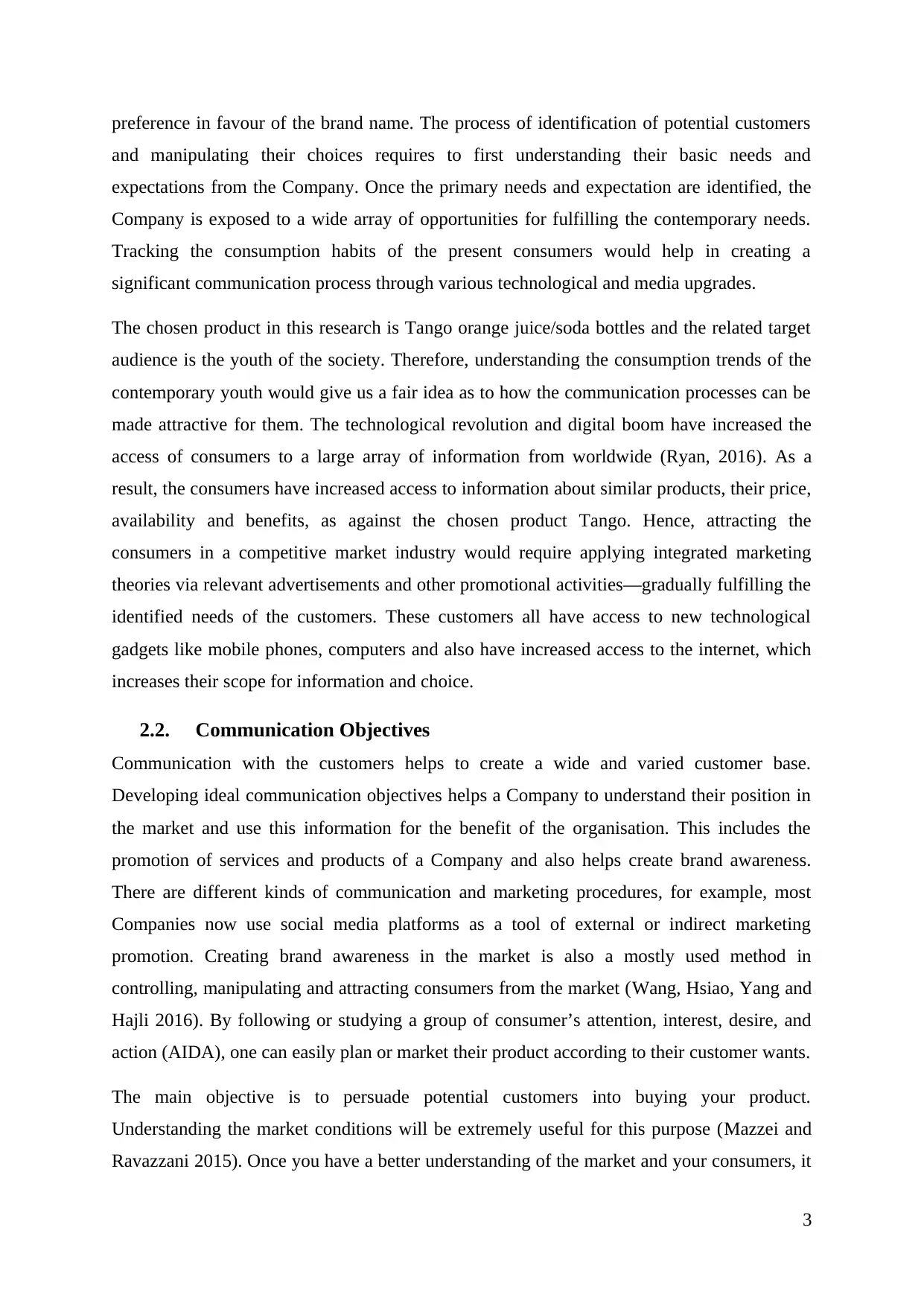
preference in favour of the brand name. The process of identification of potential customers
and manipulating their choices requires to first understanding their basic needs and
expectations from the Company. Once the primary needs and expectation are identified, the
Company is exposed to a wide array of opportunities for fulfilling the contemporary needs.
Tracking the consumption habits of the present consumers would help in creating a
significant communication process through various technological and media upgrades.
The chosen product in this research is Tango orange juice/soda bottles and the related target
audience is the youth of the society. Therefore, understanding the consumption trends of the
contemporary youth would give us a fair idea as to how the communication processes can be
made attractive for them. The technological revolution and digital boom have increased the
access of consumers to a large array of information from worldwide (Ryan, 2016). As a
result, the consumers have increased access to information about similar products, their price,
availability and benefits, as against the chosen product Tango. Hence, attracting the
consumers in a competitive market industry would require applying integrated marketing
theories via relevant advertisements and other promotional activities—gradually fulfilling the
identified needs of the customers. These customers all have access to new technological
gadgets like mobile phones, computers and also have increased access to the internet, which
increases their scope for information and choice.
2.2. Communication Objectives
Communication with the customers helps to create a wide and varied customer base.
Developing ideal communication objectives helps a Company to understand their position in
the market and use this information for the benefit of the organisation. This includes the
promotion of services and products of a Company and also helps create brand awareness.
There are different kinds of communication and marketing procedures, for example, most
Companies now use social media platforms as a tool of external or indirect marketing
promotion. Creating brand awareness in the market is also a mostly used method in
controlling, manipulating and attracting consumers from the market (Wang, Hsiao, Yang and
Hajli 2016). By following or studying a group of consumer’s attention, interest, desire, and
action (AIDA), one can easily plan or market their product according to their customer wants.
The main objective is to persuade potential customers into buying your product.
Understanding the market conditions will be extremely useful for this purpose (Mazzei and
Ravazzani 2015). Once you have a better understanding of the market and your consumers, it
3
and manipulating their choices requires to first understanding their basic needs and
expectations from the Company. Once the primary needs and expectation are identified, the
Company is exposed to a wide array of opportunities for fulfilling the contemporary needs.
Tracking the consumption habits of the present consumers would help in creating a
significant communication process through various technological and media upgrades.
The chosen product in this research is Tango orange juice/soda bottles and the related target
audience is the youth of the society. Therefore, understanding the consumption trends of the
contemporary youth would give us a fair idea as to how the communication processes can be
made attractive for them. The technological revolution and digital boom have increased the
access of consumers to a large array of information from worldwide (Ryan, 2016). As a
result, the consumers have increased access to information about similar products, their price,
availability and benefits, as against the chosen product Tango. Hence, attracting the
consumers in a competitive market industry would require applying integrated marketing
theories via relevant advertisements and other promotional activities—gradually fulfilling the
identified needs of the customers. These customers all have access to new technological
gadgets like mobile phones, computers and also have increased access to the internet, which
increases their scope for information and choice.
2.2. Communication Objectives
Communication with the customers helps to create a wide and varied customer base.
Developing ideal communication objectives helps a Company to understand their position in
the market and use this information for the benefit of the organisation. This includes the
promotion of services and products of a Company and also helps create brand awareness.
There are different kinds of communication and marketing procedures, for example, most
Companies now use social media platforms as a tool of external or indirect marketing
promotion. Creating brand awareness in the market is also a mostly used method in
controlling, manipulating and attracting consumers from the market (Wang, Hsiao, Yang and
Hajli 2016). By following or studying a group of consumer’s attention, interest, desire, and
action (AIDA), one can easily plan or market their product according to their customer wants.
The main objective is to persuade potential customers into buying your product.
Understanding the market conditions will be extremely useful for this purpose (Mazzei and
Ravazzani 2015). Once you have a better understanding of the market and your consumers, it
3
Paraphrase This Document
Need a fresh take? Get an instant paraphrase of this document with our AI Paraphraser
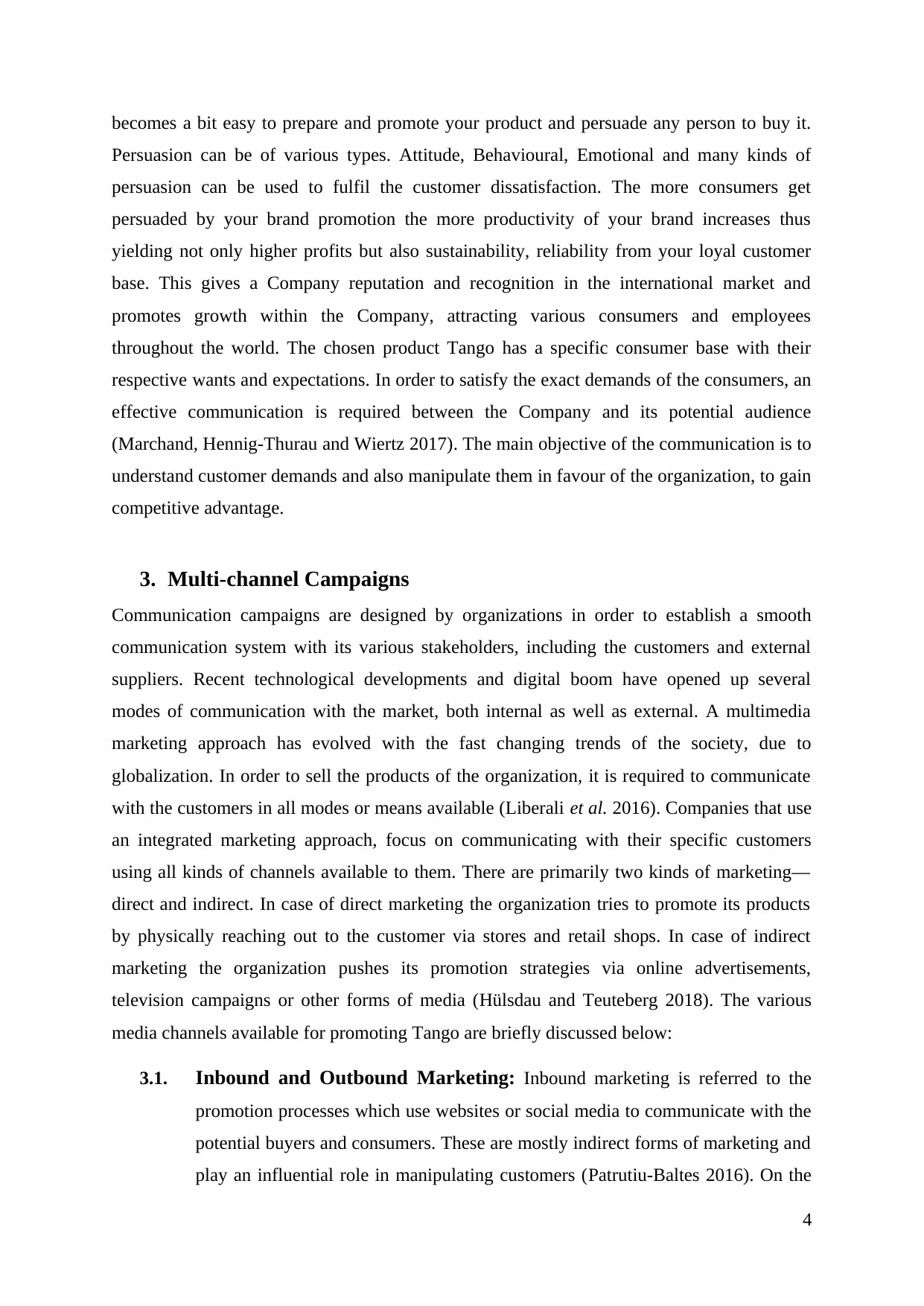
becomes a bit easy to prepare and promote your product and persuade any person to buy it.
Persuasion can be of various types. Attitude, Behavioural, Emotional and many kinds of
persuasion can be used to fulfil the customer dissatisfaction. The more consumers get
persuaded by your brand promotion the more productivity of your brand increases thus
yielding not only higher profits but also sustainability, reliability from your loyal customer
base. This gives a Company reputation and recognition in the international market and
promotes growth within the Company, attracting various consumers and employees
throughout the world. The chosen product Tango has a specific consumer base with their
respective wants and expectations. In order to satisfy the exact demands of the consumers, an
effective communication is required between the Company and its potential audience
(Marchand, Hennig-Thurau and Wiertz 2017). The main objective of the communication is to
understand customer demands and also manipulate them in favour of the organization, to gain
competitive advantage.
3. Multi-channel Campaigns
Communication campaigns are designed by organizations in order to establish a smooth
communication system with its various stakeholders, including the customers and external
suppliers. Recent technological developments and digital boom have opened up several
modes of communication with the market, both internal as well as external. A multimedia
marketing approach has evolved with the fast changing trends of the society, due to
globalization. In order to sell the products of the organization, it is required to communicate
with the customers in all modes or means available (Liberali et al. 2016). Companies that use
an integrated marketing approach, focus on communicating with their specific customers
using all kinds of channels available to them. There are primarily two kinds of marketing—
direct and indirect. In case of direct marketing the organization tries to promote its products
by physically reaching out to the customer via stores and retail shops. In case of indirect
marketing the organization pushes its promotion strategies via online advertisements,
television campaigns or other forms of media (Hülsdau and Teuteberg 2018). The various
media channels available for promoting Tango are briefly discussed below:
3.1. Inbound and Outbound Marketing: Inbound marketing is referred to the
promotion processes which use websites or social media to communicate with the
potential buyers and consumers. These are mostly indirect forms of marketing and
play an influential role in manipulating customers (Patrutiu-Baltes 2016). On the
4
Persuasion can be of various types. Attitude, Behavioural, Emotional and many kinds of
persuasion can be used to fulfil the customer dissatisfaction. The more consumers get
persuaded by your brand promotion the more productivity of your brand increases thus
yielding not only higher profits but also sustainability, reliability from your loyal customer
base. This gives a Company reputation and recognition in the international market and
promotes growth within the Company, attracting various consumers and employees
throughout the world. The chosen product Tango has a specific consumer base with their
respective wants and expectations. In order to satisfy the exact demands of the consumers, an
effective communication is required between the Company and its potential audience
(Marchand, Hennig-Thurau and Wiertz 2017). The main objective of the communication is to
understand customer demands and also manipulate them in favour of the organization, to gain
competitive advantage.
3. Multi-channel Campaigns
Communication campaigns are designed by organizations in order to establish a smooth
communication system with its various stakeholders, including the customers and external
suppliers. Recent technological developments and digital boom have opened up several
modes of communication with the market, both internal as well as external. A multimedia
marketing approach has evolved with the fast changing trends of the society, due to
globalization. In order to sell the products of the organization, it is required to communicate
with the customers in all modes or means available (Liberali et al. 2016). Companies that use
an integrated marketing approach, focus on communicating with their specific customers
using all kinds of channels available to them. There are primarily two kinds of marketing—
direct and indirect. In case of direct marketing the organization tries to promote its products
by physically reaching out to the customer via stores and retail shops. In case of indirect
marketing the organization pushes its promotion strategies via online advertisements,
television campaigns or other forms of media (Hülsdau and Teuteberg 2018). The various
media channels available for promoting Tango are briefly discussed below:
3.1. Inbound and Outbound Marketing: Inbound marketing is referred to the
promotion processes which use websites or social media to communicate with the
potential buyers and consumers. These are mostly indirect forms of marketing and
play an influential role in manipulating customers (Patrutiu-Baltes 2016). On the
4
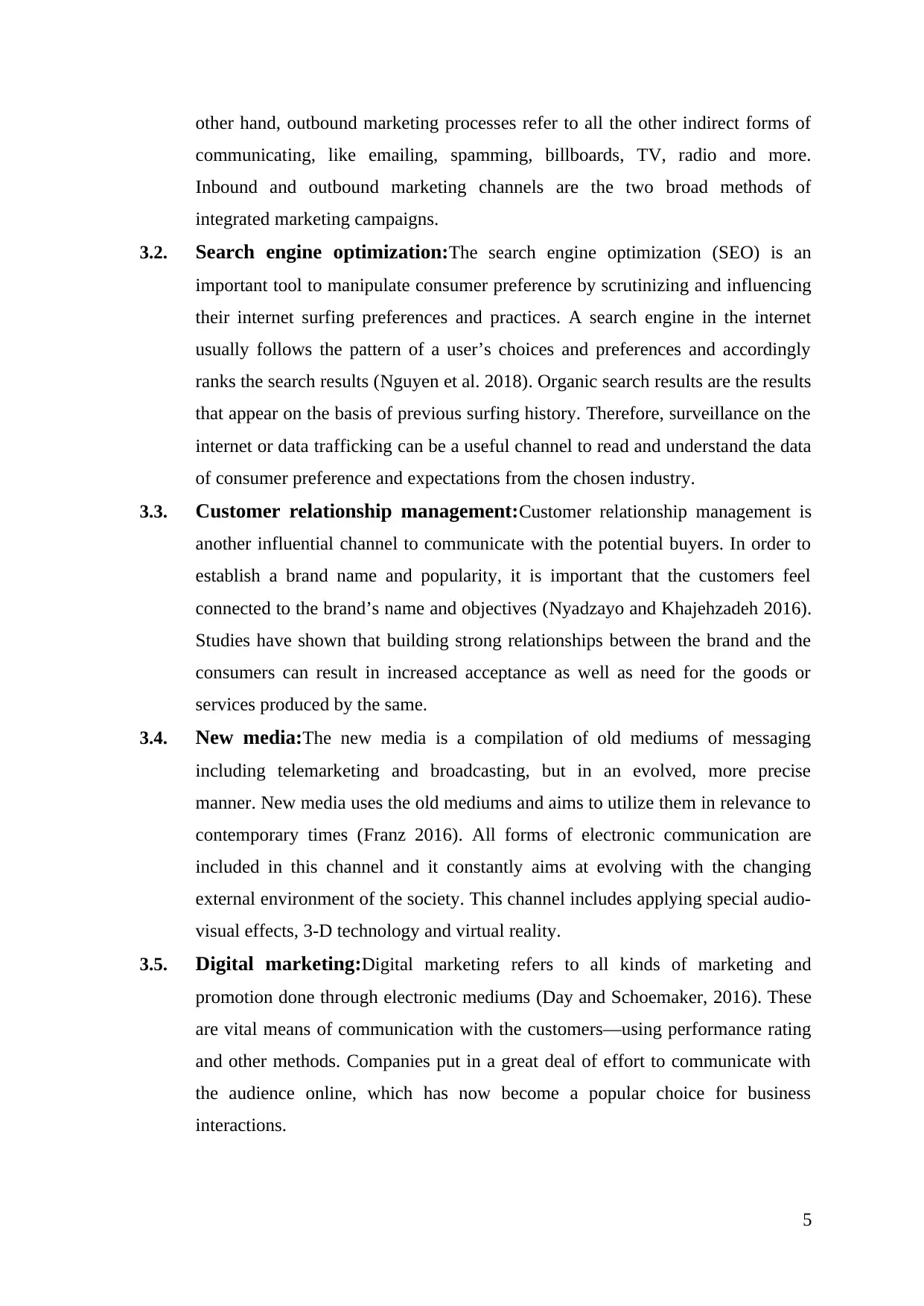
other hand, outbound marketing processes refer to all the other indirect forms of
communicating, like emailing, spamming, billboards, TV, radio and more.
Inbound and outbound marketing channels are the two broad methods of
integrated marketing campaigns.
3.2. Search engine optimization:The search engine optimization (SEO) is an
important tool to manipulate consumer preference by scrutinizing and influencing
their internet surfing preferences and practices. A search engine in the internet
usually follows the pattern of a user’s choices and preferences and accordingly
ranks the search results (Nguyen et al. 2018). Organic search results are the results
that appear on the basis of previous surfing history. Therefore, surveillance on the
internet or data trafficking can be a useful channel to read and understand the data
of consumer preference and expectations from the chosen industry.
3.3. Customer relationship management:Customer relationship management is
another influential channel to communicate with the potential buyers. In order to
establish a brand name and popularity, it is important that the customers feel
connected to the brand’s name and objectives (Nyadzayo and Khajehzadeh 2016).
Studies have shown that building strong relationships between the brand and the
consumers can result in increased acceptance as well as need for the goods or
services produced by the same.
3.4. New media:The new media is a compilation of old mediums of messaging
including telemarketing and broadcasting, but in an evolved, more precise
manner. New media uses the old mediums and aims to utilize them in relevance to
contemporary times (Franz 2016). All forms of electronic communication are
included in this channel and it constantly aims at evolving with the changing
external environment of the society. This channel includes applying special audio-
visual effects, 3-D technology and virtual reality.
3.5. Digital marketing:Digital marketing refers to all kinds of marketing and
promotion done through electronic mediums (Day and Schoemaker, 2016). These
are vital means of communication with the customers—using performance rating
and other methods. Companies put in a great deal of effort to communicate with
the audience online, which has now become a popular choice for business
interactions.
5
communicating, like emailing, spamming, billboards, TV, radio and more.
Inbound and outbound marketing channels are the two broad methods of
integrated marketing campaigns.
3.2. Search engine optimization:The search engine optimization (SEO) is an
important tool to manipulate consumer preference by scrutinizing and influencing
their internet surfing preferences and practices. A search engine in the internet
usually follows the pattern of a user’s choices and preferences and accordingly
ranks the search results (Nguyen et al. 2018). Organic search results are the results
that appear on the basis of previous surfing history. Therefore, surveillance on the
internet or data trafficking can be a useful channel to read and understand the data
of consumer preference and expectations from the chosen industry.
3.3. Customer relationship management:Customer relationship management is
another influential channel to communicate with the potential buyers. In order to
establish a brand name and popularity, it is important that the customers feel
connected to the brand’s name and objectives (Nyadzayo and Khajehzadeh 2016).
Studies have shown that building strong relationships between the brand and the
consumers can result in increased acceptance as well as need for the goods or
services produced by the same.
3.4. New media:The new media is a compilation of old mediums of messaging
including telemarketing and broadcasting, but in an evolved, more precise
manner. New media uses the old mediums and aims to utilize them in relevance to
contemporary times (Franz 2016). All forms of electronic communication are
included in this channel and it constantly aims at evolving with the changing
external environment of the society. This channel includes applying special audio-
visual effects, 3-D technology and virtual reality.
3.5. Digital marketing:Digital marketing refers to all kinds of marketing and
promotion done through electronic mediums (Day and Schoemaker, 2016). These
are vital means of communication with the customers—using performance rating
and other methods. Companies put in a great deal of effort to communicate with
the audience online, which has now become a popular choice for business
interactions.
5
⊘ This is a preview!⊘
Do you want full access?
Subscribe today to unlock all pages.

Trusted by 1+ million students worldwide
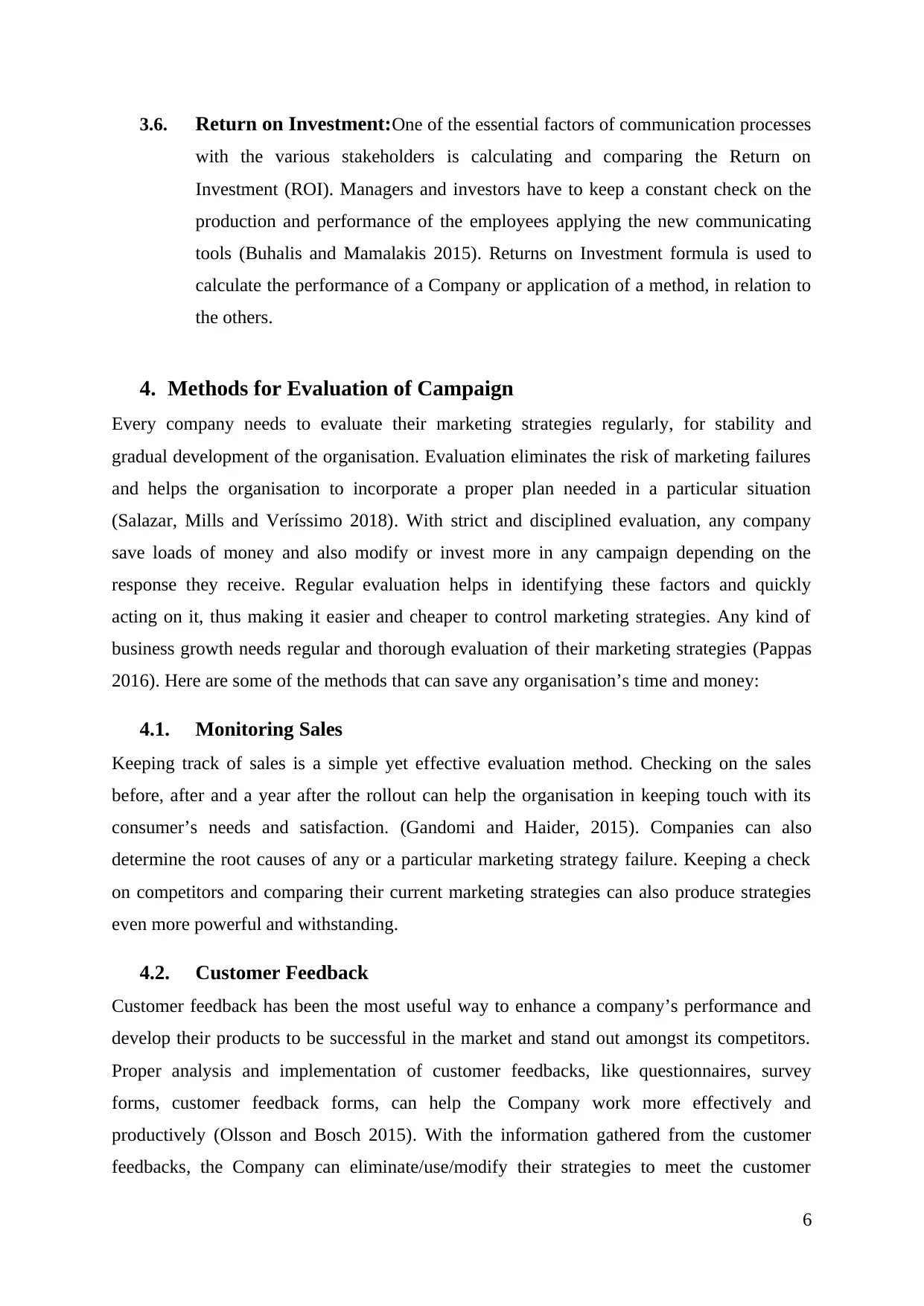
3.6. Return on Investment:One of the essential factors of communication processes
with the various stakeholders is calculating and comparing the Return on
Investment (ROI). Managers and investors have to keep a constant check on the
production and performance of the employees applying the new communicating
tools (Buhalis and Mamalakis 2015). Returns on Investment formula is used to
calculate the performance of a Company or application of a method, in relation to
the others.
4. Methods for Evaluation of Campaign
Every company needs to evaluate their marketing strategies regularly, for stability and
gradual development of the organisation. Evaluation eliminates the risk of marketing failures
and helps the organisation to incorporate a proper plan needed in a particular situation
(Salazar, Mills and Veríssimo 2018). With strict and disciplined evaluation, any company
save loads of money and also modify or invest more in any campaign depending on the
response they receive. Regular evaluation helps in identifying these factors and quickly
acting on it, thus making it easier and cheaper to control marketing strategies. Any kind of
business growth needs regular and thorough evaluation of their marketing strategies (Pappas
2016). Here are some of the methods that can save any organisation’s time and money:
4.1. Monitoring Sales
Keeping track of sales is a simple yet effective evaluation method. Checking on the sales
before, after and a year after the rollout can help the organisation in keeping touch with its
consumer’s needs and satisfaction. (Gandomi and Haider, 2015). Companies can also
determine the root causes of any or a particular marketing strategy failure. Keeping a check
on competitors and comparing their current marketing strategies can also produce strategies
even more powerful and withstanding.
4.2. Customer Feedback
Customer feedback has been the most useful way to enhance a company’s performance and
develop their products to be successful in the market and stand out amongst its competitors.
Proper analysis and implementation of customer feedbacks, like questionnaires, survey
forms, customer feedback forms, can help the Company work more effectively and
productively (Olsson and Bosch 2015). With the information gathered from the customer
feedbacks, the Company can eliminate/use/modify their strategies to meet the customer
6
with the various stakeholders is calculating and comparing the Return on
Investment (ROI). Managers and investors have to keep a constant check on the
production and performance of the employees applying the new communicating
tools (Buhalis and Mamalakis 2015). Returns on Investment formula is used to
calculate the performance of a Company or application of a method, in relation to
the others.
4. Methods for Evaluation of Campaign
Every company needs to evaluate their marketing strategies regularly, for stability and
gradual development of the organisation. Evaluation eliminates the risk of marketing failures
and helps the organisation to incorporate a proper plan needed in a particular situation
(Salazar, Mills and Veríssimo 2018). With strict and disciplined evaluation, any company
save loads of money and also modify or invest more in any campaign depending on the
response they receive. Regular evaluation helps in identifying these factors and quickly
acting on it, thus making it easier and cheaper to control marketing strategies. Any kind of
business growth needs regular and thorough evaluation of their marketing strategies (Pappas
2016). Here are some of the methods that can save any organisation’s time and money:
4.1. Monitoring Sales
Keeping track of sales is a simple yet effective evaluation method. Checking on the sales
before, after and a year after the rollout can help the organisation in keeping touch with its
consumer’s needs and satisfaction. (Gandomi and Haider, 2015). Companies can also
determine the root causes of any or a particular marketing strategy failure. Keeping a check
on competitors and comparing their current marketing strategies can also produce strategies
even more powerful and withstanding.
4.2. Customer Feedback
Customer feedback has been the most useful way to enhance a company’s performance and
develop their products to be successful in the market and stand out amongst its competitors.
Proper analysis and implementation of customer feedbacks, like questionnaires, survey
forms, customer feedback forms, can help the Company work more effectively and
productively (Olsson and Bosch 2015). With the information gathered from the customer
feedbacks, the Company can eliminate/use/modify their strategies to meet the customer
6
Paraphrase This Document
Need a fresh take? Get an instant paraphrase of this document with our AI Paraphraser
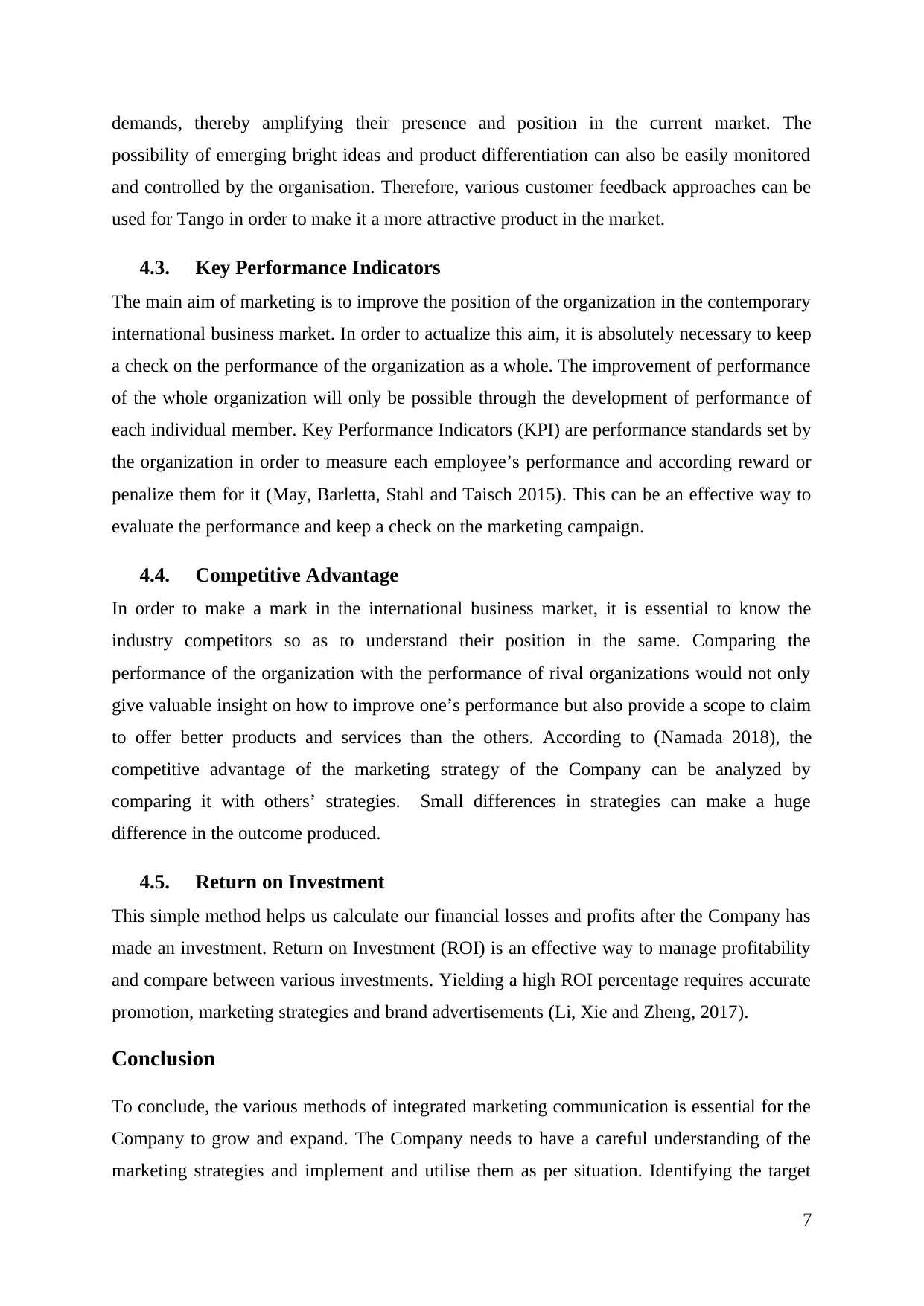
demands, thereby amplifying their presence and position in the current market. The
possibility of emerging bright ideas and product differentiation can also be easily monitored
and controlled by the organisation. Therefore, various customer feedback approaches can be
used for Tango in order to make it a more attractive product in the market.
4.3. Key Performance Indicators
The main aim of marketing is to improve the position of the organization in the contemporary
international business market. In order to actualize this aim, it is absolutely necessary to keep
a check on the performance of the organization as a whole. The improvement of performance
of the whole organization will only be possible through the development of performance of
each individual member. Key Performance Indicators (KPI) are performance standards set by
the organization in order to measure each employee’s performance and according reward or
penalize them for it (May, Barletta, Stahl and Taisch 2015). This can be an effective way to
evaluate the performance and keep a check on the marketing campaign.
4.4. Competitive Advantage
In order to make a mark in the international business market, it is essential to know the
industry competitors so as to understand their position in the same. Comparing the
performance of the organization with the performance of rival organizations would not only
give valuable insight on how to improve one’s performance but also provide a scope to claim
to offer better products and services than the others. According to (Namada 2018), the
competitive advantage of the marketing strategy of the Company can be analyzed by
comparing it with others’ strategies. Small differences in strategies can make a huge
difference in the outcome produced.
4.5. Return on Investment
This simple method helps us calculate our financial losses and profits after the Company has
made an investment. Return on Investment (ROI) is an effective way to manage profitability
and compare between various investments. Yielding a high ROI percentage requires accurate
promotion, marketing strategies and brand advertisements (Li, Xie and Zheng, 2017).
Conclusion
To conclude, the various methods of integrated marketing communication is essential for the
Company to grow and expand. The Company needs to have a careful understanding of the
marketing strategies and implement and utilise them as per situation. Identifying the target
7
possibility of emerging bright ideas and product differentiation can also be easily monitored
and controlled by the organisation. Therefore, various customer feedback approaches can be
used for Tango in order to make it a more attractive product in the market.
4.3. Key Performance Indicators
The main aim of marketing is to improve the position of the organization in the contemporary
international business market. In order to actualize this aim, it is absolutely necessary to keep
a check on the performance of the organization as a whole. The improvement of performance
of the whole organization will only be possible through the development of performance of
each individual member. Key Performance Indicators (KPI) are performance standards set by
the organization in order to measure each employee’s performance and according reward or
penalize them for it (May, Barletta, Stahl and Taisch 2015). This can be an effective way to
evaluate the performance and keep a check on the marketing campaign.
4.4. Competitive Advantage
In order to make a mark in the international business market, it is essential to know the
industry competitors so as to understand their position in the same. Comparing the
performance of the organization with the performance of rival organizations would not only
give valuable insight on how to improve one’s performance but also provide a scope to claim
to offer better products and services than the others. According to (Namada 2018), the
competitive advantage of the marketing strategy of the Company can be analyzed by
comparing it with others’ strategies. Small differences in strategies can make a huge
difference in the outcome produced.
4.5. Return on Investment
This simple method helps us calculate our financial losses and profits after the Company has
made an investment. Return on Investment (ROI) is an effective way to manage profitability
and compare between various investments. Yielding a high ROI percentage requires accurate
promotion, marketing strategies and brand advertisements (Li, Xie and Zheng, 2017).
Conclusion
To conclude, the various methods of integrated marketing communication is essential for the
Company to grow and expand. The Company needs to have a careful understanding of the
marketing strategies and implement and utilise them as per situation. Identifying the target
7
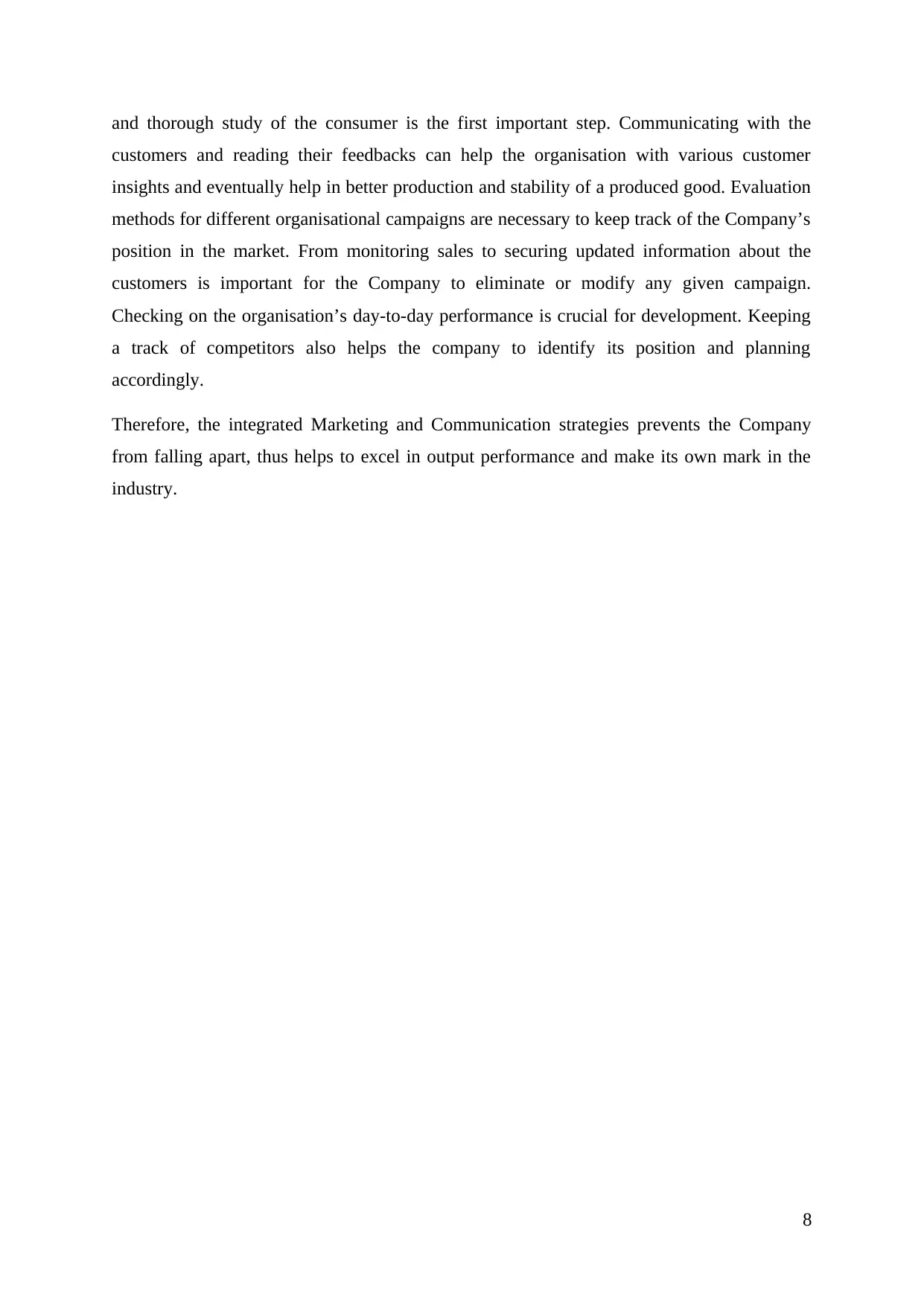
and thorough study of the consumer is the first important step. Communicating with the
customers and reading their feedbacks can help the organisation with various customer
insights and eventually help in better production and stability of a produced good. Evaluation
methods for different organisational campaigns are necessary to keep track of the Company’s
position in the market. From monitoring sales to securing updated information about the
customers is important for the Company to eliminate or modify any given campaign.
Checking on the organisation’s day-to-day performance is crucial for development. Keeping
a track of competitors also helps the company to identify its position and planning
accordingly.
Therefore, the integrated Marketing and Communication strategies prevents the Company
from falling apart, thus helps to excel in output performance and make its own mark in the
industry.
8
customers and reading their feedbacks can help the organisation with various customer
insights and eventually help in better production and stability of a produced good. Evaluation
methods for different organisational campaigns are necessary to keep track of the Company’s
position in the market. From monitoring sales to securing updated information about the
customers is important for the Company to eliminate or modify any given campaign.
Checking on the organisation’s day-to-day performance is crucial for development. Keeping
a track of competitors also helps the company to identify its position and planning
accordingly.
Therefore, the integrated Marketing and Communication strategies prevents the Company
from falling apart, thus helps to excel in output performance and make its own mark in the
industry.
8
⊘ This is a preview!⊘
Do you want full access?
Subscribe today to unlock all pages.

Trusted by 1+ million students worldwide
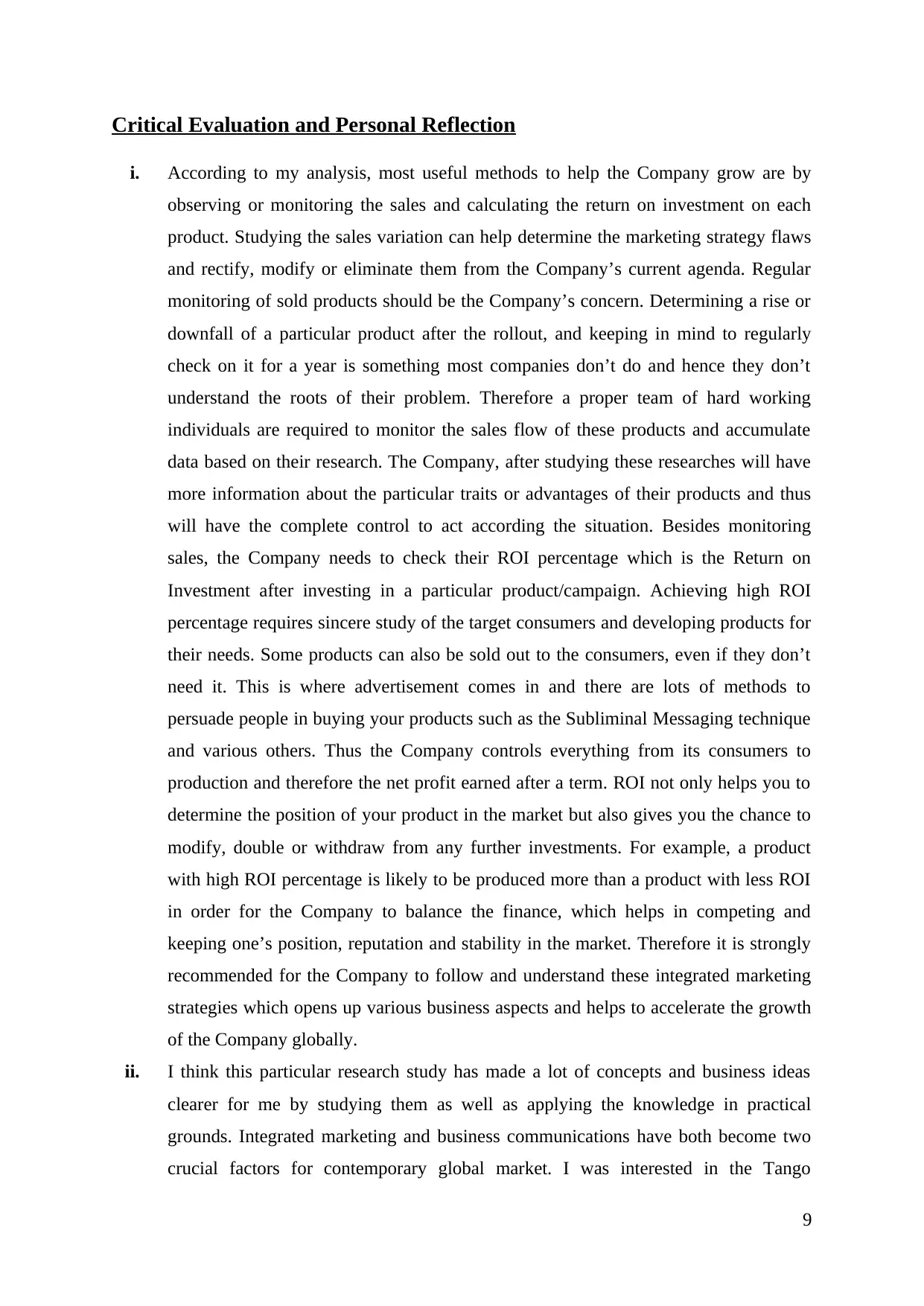
Critical Evaluation and Personal Reflection
i. According to my analysis, most useful methods to help the Company grow are by
observing or monitoring the sales and calculating the return on investment on each
product. Studying the sales variation can help determine the marketing strategy flaws
and rectify, modify or eliminate them from the Company’s current agenda. Regular
monitoring of sold products should be the Company’s concern. Determining a rise or
downfall of a particular product after the rollout, and keeping in mind to regularly
check on it for a year is something most companies don’t do and hence they don’t
understand the roots of their problem. Therefore a proper team of hard working
individuals are required to monitor the sales flow of these products and accumulate
data based on their research. The Company, after studying these researches will have
more information about the particular traits or advantages of their products and thus
will have the complete control to act according the situation. Besides monitoring
sales, the Company needs to check their ROI percentage which is the Return on
Investment after investing in a particular product/campaign. Achieving high ROI
percentage requires sincere study of the target consumers and developing products for
their needs. Some products can also be sold out to the consumers, even if they don’t
need it. This is where advertisement comes in and there are lots of methods to
persuade people in buying your products such as the Subliminal Messaging technique
and various others. Thus the Company controls everything from its consumers to
production and therefore the net profit earned after a term. ROI not only helps you to
determine the position of your product in the market but also gives you the chance to
modify, double or withdraw from any further investments. For example, a product
with high ROI percentage is likely to be produced more than a product with less ROI
in order for the Company to balance the finance, which helps in competing and
keeping one’s position, reputation and stability in the market. Therefore it is strongly
recommended for the Company to follow and understand these integrated marketing
strategies which opens up various business aspects and helps to accelerate the growth
of the Company globally.
ii. I think this particular research study has made a lot of concepts and business ideas
clearer for me by studying them as well as applying the knowledge in practical
grounds. Integrated marketing and business communications have both become two
crucial factors for contemporary global market. I was interested in the Tango
9
i. According to my analysis, most useful methods to help the Company grow are by
observing or monitoring the sales and calculating the return on investment on each
product. Studying the sales variation can help determine the marketing strategy flaws
and rectify, modify or eliminate them from the Company’s current agenda. Regular
monitoring of sold products should be the Company’s concern. Determining a rise or
downfall of a particular product after the rollout, and keeping in mind to regularly
check on it for a year is something most companies don’t do and hence they don’t
understand the roots of their problem. Therefore a proper team of hard working
individuals are required to monitor the sales flow of these products and accumulate
data based on their research. The Company, after studying these researches will have
more information about the particular traits or advantages of their products and thus
will have the complete control to act according the situation. Besides monitoring
sales, the Company needs to check their ROI percentage which is the Return on
Investment after investing in a particular product/campaign. Achieving high ROI
percentage requires sincere study of the target consumers and developing products for
their needs. Some products can also be sold out to the consumers, even if they don’t
need it. This is where advertisement comes in and there are lots of methods to
persuade people in buying your products such as the Subliminal Messaging technique
and various others. Thus the Company controls everything from its consumers to
production and therefore the net profit earned after a term. ROI not only helps you to
determine the position of your product in the market but also gives you the chance to
modify, double or withdraw from any further investments. For example, a product
with high ROI percentage is likely to be produced more than a product with less ROI
in order for the Company to balance the finance, which helps in competing and
keeping one’s position, reputation and stability in the market. Therefore it is strongly
recommended for the Company to follow and understand these integrated marketing
strategies which opens up various business aspects and helps to accelerate the growth
of the Company globally.
ii. I think this particular research study has made a lot of concepts and business ideas
clearer for me by studying them as well as applying the knowledge in practical
grounds. Integrated marketing and business communications have both become two
crucial factors for contemporary global market. I was interested in the Tango
9
Paraphrase This Document
Need a fresh take? Get an instant paraphrase of this document with our AI Paraphraser
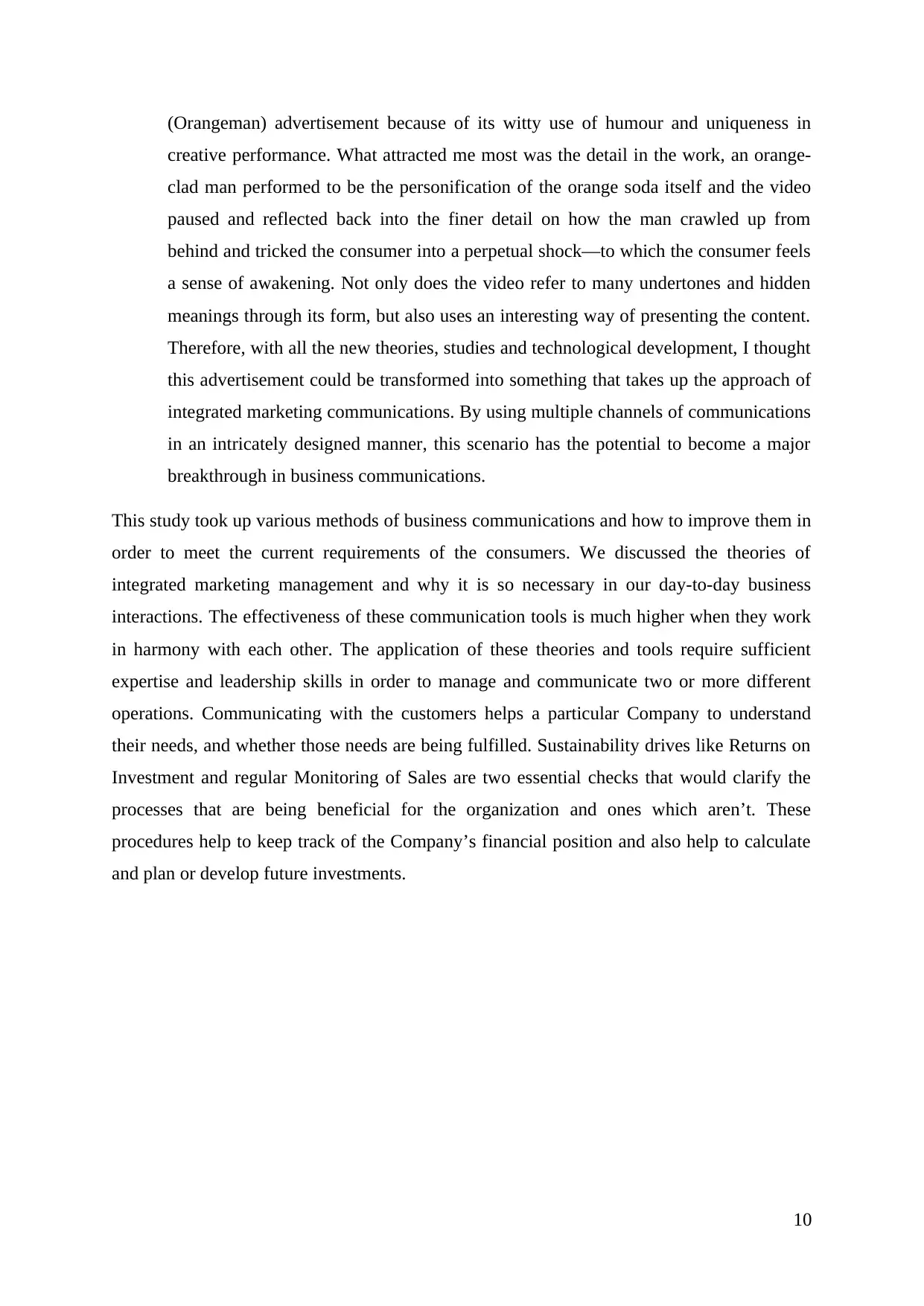
(Orangeman) advertisement because of its witty use of humour and uniqueness in
creative performance. What attracted me most was the detail in the work, an orange-
clad man performed to be the personification of the orange soda itself and the video
paused and reflected back into the finer detail on how the man crawled up from
behind and tricked the consumer into a perpetual shock—to which the consumer feels
a sense of awakening. Not only does the video refer to many undertones and hidden
meanings through its form, but also uses an interesting way of presenting the content.
Therefore, with all the new theories, studies and technological development, I thought
this advertisement could be transformed into something that takes up the approach of
integrated marketing communications. By using multiple channels of communications
in an intricately designed manner, this scenario has the potential to become a major
breakthrough in business communications.
This study took up various methods of business communications and how to improve them in
order to meet the current requirements of the consumers. We discussed the theories of
integrated marketing management and why it is so necessary in our day-to-day business
interactions. The effectiveness of these communication tools is much higher when they work
in harmony with each other. The application of these theories and tools require sufficient
expertise and leadership skills in order to manage and communicate two or more different
operations. Communicating with the customers helps a particular Company to understand
their needs, and whether those needs are being fulfilled. Sustainability drives like Returns on
Investment and regular Monitoring of Sales are two essential checks that would clarify the
processes that are being beneficial for the organization and ones which aren’t. These
procedures help to keep track of the Company’s financial position and also help to calculate
and plan or develop future investments.
10
creative performance. What attracted me most was the detail in the work, an orange-
clad man performed to be the personification of the orange soda itself and the video
paused and reflected back into the finer detail on how the man crawled up from
behind and tricked the consumer into a perpetual shock—to which the consumer feels
a sense of awakening. Not only does the video refer to many undertones and hidden
meanings through its form, but also uses an interesting way of presenting the content.
Therefore, with all the new theories, studies and technological development, I thought
this advertisement could be transformed into something that takes up the approach of
integrated marketing communications. By using multiple channels of communications
in an intricately designed manner, this scenario has the potential to become a major
breakthrough in business communications.
This study took up various methods of business communications and how to improve them in
order to meet the current requirements of the consumers. We discussed the theories of
integrated marketing management and why it is so necessary in our day-to-day business
interactions. The effectiveness of these communication tools is much higher when they work
in harmony with each other. The application of these theories and tools require sufficient
expertise and leadership skills in order to manage and communicate two or more different
operations. Communicating with the customers helps a particular Company to understand
their needs, and whether those needs are being fulfilled. Sustainability drives like Returns on
Investment and regular Monitoring of Sales are two essential checks that would clarify the
processes that are being beneficial for the organization and ones which aren’t. These
procedures help to keep track of the Company’s financial position and also help to calculate
and plan or develop future investments.
10
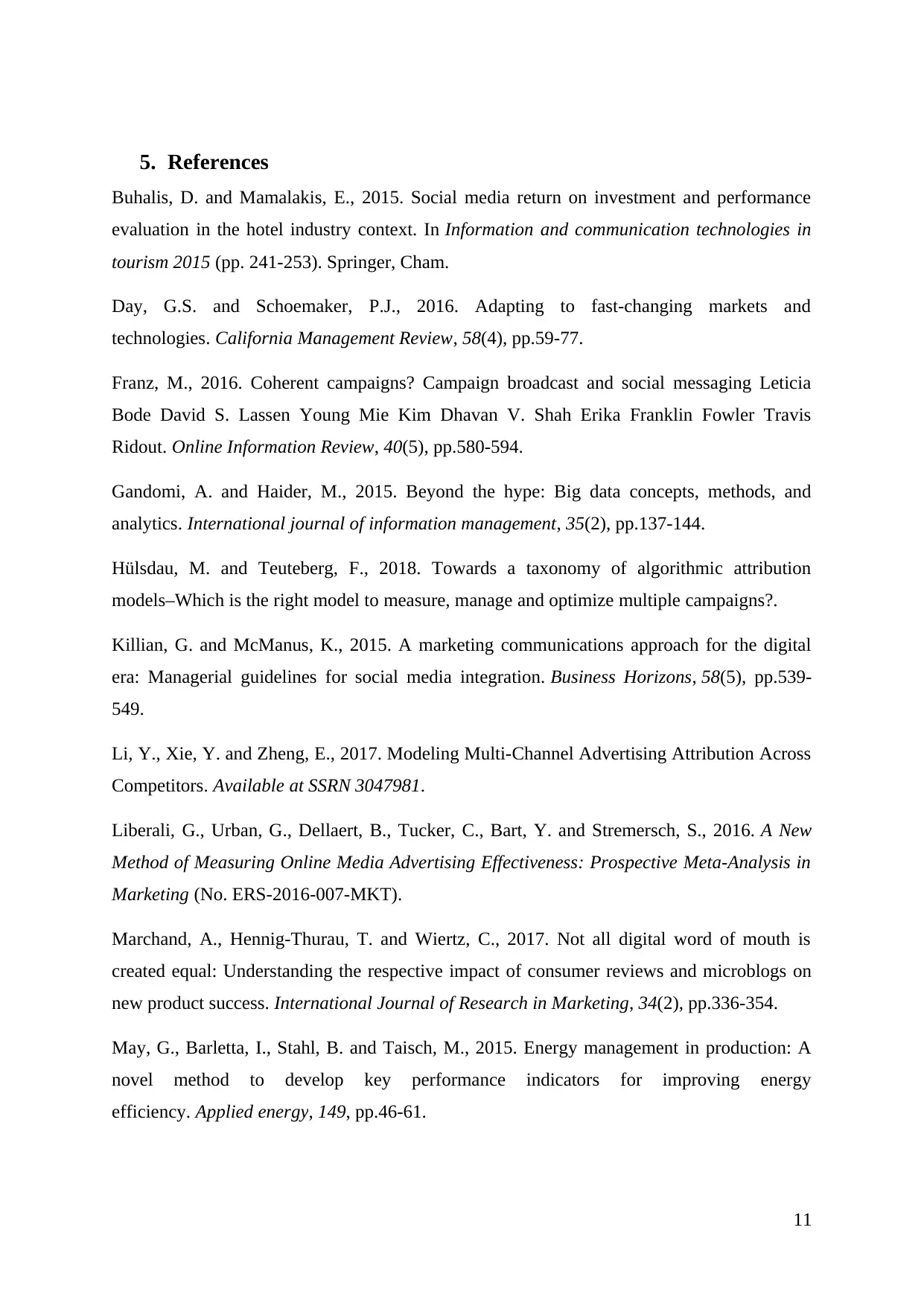
5. References
Buhalis, D. and Mamalakis, E., 2015. Social media return on investment and performance
evaluation in the hotel industry context. In Information and communication technologies in
tourism 2015 (pp. 241-253). Springer, Cham.
Day, G.S. and Schoemaker, P.J., 2016. Adapting to fast-changing markets and
technologies. California Management Review, 58(4), pp.59-77.
Franz, M., 2016. Coherent campaigns? Campaign broadcast and social messaging Leticia
Bode David S. Lassen Young Mie Kim Dhavan V. Shah Erika Franklin Fowler Travis
Ridout. Online Information Review, 40(5), pp.580-594.
Gandomi, A. and Haider, M., 2015. Beyond the hype: Big data concepts, methods, and
analytics. International journal of information management, 35(2), pp.137-144.
Hülsdau, M. and Teuteberg, F., 2018. Towards a taxonomy of algorithmic attribution
models–Which is the right model to measure, manage and optimize multiple campaigns?.
Killian, G. and McManus, K., 2015. A marketing communications approach for the digital
era: Managerial guidelines for social media integration. Business Horizons, 58(5), pp.539-
549.
Li, Y., Xie, Y. and Zheng, E., 2017. Modeling Multi-Channel Advertising Attribution Across
Competitors. Available at SSRN 3047981.
Liberali, G., Urban, G., Dellaert, B., Tucker, C., Bart, Y. and Stremersch, S., 2016. A New
Method of Measuring Online Media Advertising Effectiveness: Prospective Meta-Analysis in
Marketing (No. ERS-2016-007-MKT).
Marchand, A., Hennig-Thurau, T. and Wiertz, C., 2017. Not all digital word of mouth is
created equal: Understanding the respective impact of consumer reviews and microblogs on
new product success. International Journal of Research in Marketing, 34(2), pp.336-354.
May, G., Barletta, I., Stahl, B. and Taisch, M., 2015. Energy management in production: A
novel method to develop key performance indicators for improving energy
efficiency. Applied energy, 149, pp.46-61.
11
Buhalis, D. and Mamalakis, E., 2015. Social media return on investment and performance
evaluation in the hotel industry context. In Information and communication technologies in
tourism 2015 (pp. 241-253). Springer, Cham.
Day, G.S. and Schoemaker, P.J., 2016. Adapting to fast-changing markets and
technologies. California Management Review, 58(4), pp.59-77.
Franz, M., 2016. Coherent campaigns? Campaign broadcast and social messaging Leticia
Bode David S. Lassen Young Mie Kim Dhavan V. Shah Erika Franklin Fowler Travis
Ridout. Online Information Review, 40(5), pp.580-594.
Gandomi, A. and Haider, M., 2015. Beyond the hype: Big data concepts, methods, and
analytics. International journal of information management, 35(2), pp.137-144.
Hülsdau, M. and Teuteberg, F., 2018. Towards a taxonomy of algorithmic attribution
models–Which is the right model to measure, manage and optimize multiple campaigns?.
Killian, G. and McManus, K., 2015. A marketing communications approach for the digital
era: Managerial guidelines for social media integration. Business Horizons, 58(5), pp.539-
549.
Li, Y., Xie, Y. and Zheng, E., 2017. Modeling Multi-Channel Advertising Attribution Across
Competitors. Available at SSRN 3047981.
Liberali, G., Urban, G., Dellaert, B., Tucker, C., Bart, Y. and Stremersch, S., 2016. A New
Method of Measuring Online Media Advertising Effectiveness: Prospective Meta-Analysis in
Marketing (No. ERS-2016-007-MKT).
Marchand, A., Hennig-Thurau, T. and Wiertz, C., 2017. Not all digital word of mouth is
created equal: Understanding the respective impact of consumer reviews and microblogs on
new product success. International Journal of Research in Marketing, 34(2), pp.336-354.
May, G., Barletta, I., Stahl, B. and Taisch, M., 2015. Energy management in production: A
novel method to develop key performance indicators for improving energy
efficiency. Applied energy, 149, pp.46-61.
11
⊘ This is a preview!⊘
Do you want full access?
Subscribe today to unlock all pages.

Trusted by 1+ million students worldwide
1 out of 14
Related Documents
Your All-in-One AI-Powered Toolkit for Academic Success.
+13062052269
info@desklib.com
Available 24*7 on WhatsApp / Email
![[object Object]](/_next/static/media/star-bottom.7253800d.svg)
Unlock your academic potential
Copyright © 2020–2025 A2Z Services. All Rights Reserved. Developed and managed by ZUCOL.





